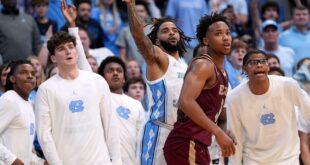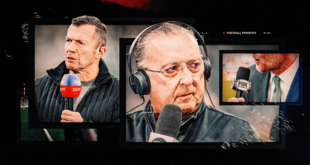In spring 2020, as the COVID-19 pandemic upended the country, WNBA commissioner Cathy Engelbert was locked down in her New Jersey home. The league was facing a season on the brink right as its stakeholders felt it had begun to gather momentum.
In conversations with league owners and players, Engelbert sensed in those early weeks of the pandemic the tension over what was at stake. Without a season, the league faced what she later called an “existential” moment about the prospect of going dark for 20 months.
“I don’t know if we would have made it, but I do know we wouldn’t be where we are today without having had that highly competitive 22-game season in the bubble,” Engelbert said.
Four years after the “Wubble,” the league is celebrating the WNBA Finals between the New York Liberty and Minnesota Lynx as a capstone to its most successful year. The WNBA has never been in a better place. Television ratings are up. So is attendance. The league is riding a boom in interest and talent, driven by the steady excellence of longtime stars like A’ja Wilson and Breanna Stewart, and the arrival of Caitlin Clark. Three expansion teams have already been named and another is expected. A lucrative new media deal is set to start in 2026.
LIBERTY LEVELS UP 🗽
The #WNBAFinals presented by @YouTubeTV is now tied at 1-1! Game 3 is set for Wednesday at 8pm/ET in Minneapolis 🔥 pic.twitter.com/sZOjIZSZZW
— WNBA (@WNBA) October 13, 2024
The progress has not been without its growing pains. For years, WNBA players pushed for private charter flights for teams traveling between games — a common practice for their peers in the NBA and most other major professional sports leagues — before the league granted them this season. Occasional high-profile games have been moved because of scheduling conflicts, and fans have voiced frustration about merchandise and broadcast accessibility. Engelbert received criticism from players, including an admonishment from the players’ union, last month for what they said was an inadequate public response to the online harassment and abuse many said they’ve received this season. The union has also routinely called for more transparency from the league on its finances and operations.
But the league remains on the ascent, and the choice to play in 2020 has been hailed by team owners as an important springboard. “I think it was one of the best decisions made in the history of this league,” Seattle Storm co-owner Lisa Brummel said.
That decision kept the WNBA in the consciousness of fans and created a strengthened player body. As important, it continued to generate revenue via media rights and corporate partnerships.
A few months after the conclusion of the 2020 season, the WNBA made another choice that significantly affected its trajectory. It began a capital raise that has helped supercharge its reach and popularity. It didn’t have to come in from the shadows to do so. If not for that window of time, stakeholders say, the WNBA might not be where it is now.
Before Engelbert took over as the WNBA’s first official commissioner in 2019 — the league was previously run by presidents — she had to interview with the league’s team owners. As she went around the country, visiting all 12 markets, she heard a similar refrain. After nearly three decades of trying to find its footing, the WNBA’s power brokers had decided it was time to grow. The plan, Engelbert said, was based on a simple idea: “Go big or go home.” The league, they told her, needed more capital.
There was no consensus on how much. Just that it needed more to grow. Engelbert sought perspectives from influential people around her. When she met Kobe Bryant late that year, she said he asked what the WNBA needed. Engelbert passed along the desire for more capital and floated $50 million as a target. That number turned out to be a fraction of what it later received from investors.
In early 2021, the WNBA put out a pitch deck to investors. The process was driven, in part, by the Liberty’s ownership group, which also owns the Brooklyn Nets and Blue Pool Capital, a private equity firm. “At the time, we really needed that infusion of capital,” Liberty co-owner Clara Wu Tsai said.
It was a new approach by the WNBA. The NBA had helped stand up the league over its first two-plus decades in existence, but now it sought money from other sources. The WNBA was short on resources and manpower. It needed investments to put into marketing and brand building, digital innovation and to drive more revenue.
A year later, it closed a $75 million capital raise that came with a $475 million post-money valuation for the WNBA. Michael Dell and Nike were the largest investors, according to one source with knowledge of the raise who was not authorized to speak publicly about the agreement. Nike invested $25 million, according to multiple league and industry sources. Nike declined to comment. Engelbert did not dispute that number when asked but said the sneaker company was a natural partner.
“Nike called and wanted to make a substantial investment because part of their strategy was to double down on women’s sports,” she said.
Investors in the capital raise took a roughly 16 percent stake in the league, with WNBA owners and NBA owners each splitting the rest in half, and took preferred equity. That gives them a priority return on their investment with a 5 percent dividend, said one person with knowledge of the capital raise who was granted anonymity because the person did not have the authority to speak publicly about the league’s financial structure. Though they have non-voting shares in the league, they also have two observers on the Board of Governors.
“I was just intrigued that there was this league where the quality of the players is so great,” Karen Finerman, Metropolitan Capital CEO and a WNBA investor, said. “And yet the league was struggling.”
The WNBA’s financial situation has improved since then, and high-ranking executives and owners point to the raise as a reason. It helped supercharge the league’s growth and put the WNBA in a place where it could take advantage of the surge in popularity since 2020.
Increased globalization was announced as one of the uses of the money. After playing multiple exhibition games in Canada, a Toronto expansion team will begin play in 2026. Engelbert said the league would like to play games on various continents. Last week, she singled out Mexico City for its interest in hosting competition. The WNBA has also undergone a digital transformation after the raise, revamping its app and website. That change also helped with its marketing efforts, as did increases in promotional and paid media campaigns.
Human capital was another area where the money was allocated. When Engelbert took over as commissioner, the WNBA had roughly 12 employees, she said. It still works out of the NBA’s midtown Manhattan offices, but now it has more than 60. It has gone from what Engelbert said was a one-person marketing department to around two dozen employees there. The league hired its first chief marketing officer in December 2020.
“If we weren’t already making incremental progress in our business, then the moment that we’re experiencing right now would not be as big as it is,” Dallas Wings CEO and president Greg Bibb said.

WNBA commissioner Cathy Engelbert took a “go big or go home” approach to running the league. (David L. Nemec / NBAE via Getty Images)
Engelbert believed the capital raise also showed the WNBA could be a growth property. That wasn’t always the case for teams around the league.
When Wu Tsai and her husband, Joe Tsai, bought the Liberty in January 2019, they purchased an organization she said was a distressed asset. James Dolan, the franchise’s first and then-only owner, put the Liberty for sale in November 2017, and moved it out of Madison Square Garden a season later and into Westchester County Center, where they played for two seasons.
“Nobody wanted to touch it,” Wu Tsai said.
Nevertheless, the Tsais found the franchise attractive. They recognized the power of New York as a media market and knew how much the city loved basketball. They believed there was a fan base just waiting to be reinvigorated.
Entering the finals, New York has been re-energized and is viewed around the league as one of the franchises responsible for raising the bar. (Before the WNBA implemented full charter travel this season, the Liberty were fined a league-record $500,000 for chartering their players during the second half of 2021.)
They reshaped the roster and the business, too. In New York’s opener against the Indiana Fever, it recorded $175,000 in merchandise sales, a single-game record for the Liberty and the Nets. Attendance is up to an average of nearly 13,000 fans per Liberty home game, up 64 percent from last year. They have 53 sponsors, up nearly 61 percent year over year, with revenue generated from such partnerships up 68 percent. Wu Tsai said the franchise is heading in the direction of profitability.
“I couldn’t be happier about the demand for tickets for our games, the interest from sponsors and the viewership,” Wu Tsai said.
SOLD OUT DATES 🤩
Huge shoutout to our Libs Fam for showing up and out for a Game 2 win @barclayscenter 🗽 pic.twitter.com/KjNlFBzCWN
— New York Liberty (@nyliberty) October 13, 2024
They aren’t alone, of course. Clark has served as an accelerant in a record-setting year for the Fever (and league more broadly). The Wings rebudgeted their ticket revenue three times this season as a reflection of exploding interest, with signs pointing to another record year next season, Bibb said. They set merchandise records and added more partners, ones who aren’t just local but also national and international brands. They sold two half-percent ownership stakes this summer at a record $208 million valuation.
Transformations in the business also are part of what set the Wings up for a forthcoming move from Arlington to downtown Dallas. They are targeting to begin working in a new practice facility by the start of the 2026 season. The Dallas Memorial Auditorium is undergoing a renovation and will serve as their home arena. “It just changes the game for us,” Bibb said.
The Chicago Sky, led by rookie Angel Reese, have experienced a similar upswing.
“We now have breathing room. Revenue is good. Growing the top line is good. People coming to games and selling out arenas, that’s fantastic,” co-owner and operating chairperson Nadia Rawlinson said. “What has happened over the last 18 months has been nothing short of extraordinary.”
A franchise-specific 40,000-square-foot practice facility is on the way in Chicago. The Sky broke ground on their new facility Oct. 9 with plans to open before the 2026 season. They join Phoenix, Seattle and Las Vegas as franchises that have all recently unveiled new facilities.
“Practice facilities are going to just quickly become table stakes,” Rawlinson said. “I think it will be something most franchises, if not all, will have over the next five years.”
She’s not alone in that belief. Storm co-owner Ginny Gilder said she believes that in five years every franchise will have its own practice facility. If that comes to fruition, it will be one more example of how far the league has come.
“This was a leap (from) many years where people thought, is this going to be sustainable?” said Joe Soper, the governor for the Connecticut Sun. “Are there going to be teams choosing to fold or sell or relocate and just trying to get out because they don’t know if financially it’s going to have the support, even though the talent is there on the court. Now you’re getting this visibility, and everybody gets to see the talent and the growth.”
The WNBA has seen franchise valuations jump, and Engelbert said she thinks they will continue to rise “considerably.” It is a stark difference from a half-decade ago when franchises were sold at values in the single-digit millions. Mark Davis, The Athletic reported in 2022, bought the Las Vegas Aces for a little more than $2 million.
This year, the league drew an all-in fee of $125 million for the expansion franchise in Portland, more than doubling not only what the league sought in expansion fees when it started but also what it cost the Golden State Warriors ownership group to buy in with the Valkyries.

GO DEEPER
How the Golden State Valkyries marketing themselves as the new WNBA expansion franchise
This past season, WNBA games averaged a record 1.19 million viewers on ESPN platforms compared with an average of 1.56 million viewers tuning in to watch NBA regular-season games across ABC, ESPN and TNT. And heading into the finals, the playoffs had been the most viewed in 25 years. The league’s new media deal — worth $2.2 billion over 11 years, and potentially more if it lands additional media partners, as it expects — could help lift valuations even higher. There has been so much positive momentum, Engelbert said, that the league decided to pause the search for its 16th team to reassess where it stands and hire an investment banker to run it. She said 10 to 12 cities are viable options.
It is one of several ways the WNBA has had to reorient itself on the fly.
“It’s interesting to talk today about where we are, but I think it’s changing so rapidly, and everything’s changing in the W,” Engelbert said. “I tell my team, everything’s changed, so don’t base this on last year because everything changed this year and how we should be thinking about what’s next for us.”
The next few years will continue to mold the league. The WNBPA is widely expected to opt out of the current collective bargaining agreement, and there could be a new one in place in 2026, the same year the new media deals kick in. The new CBA will determine what proportion of revenue players and teams get.
Players have pushed for higher salaries at a time when the WNBA has had to deal with criticism that they aren’t being paid enough. Teams, after decades of losing money, are hoping to soon crawl into the black. Valkyries president Jess Smith didn’t dismiss profitability in the franchise’s first season.
Though the WNBA’s new media deal is relatively flush, it won’t all trickle down to the teams in the same way it would in the NBA or NFL, which don’t have outside investors. The income the league distributes will hit teams through a waterfall process, though team owners will get the largest share.
But there is a belief across the league that the WNBA is entering a different stage. Its recent prosperity, its stakeholders say, should become normal.
“This is the new baseline,” Rawlinson said.
(Illustration: Dan Goldfarb / The Athletic; photo: Bruce Bennett/ Getty Images)
 meganwoolsey Home
meganwoolsey Home



